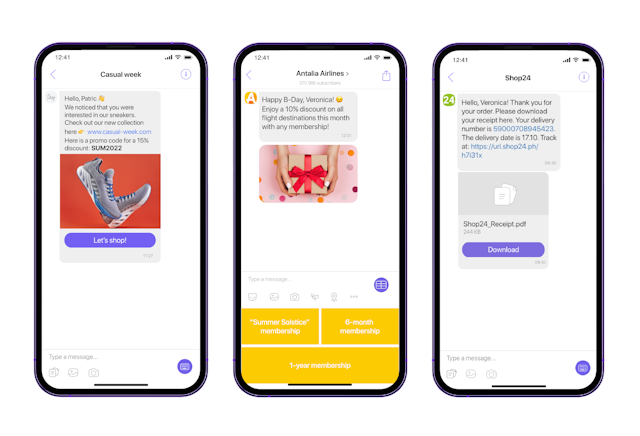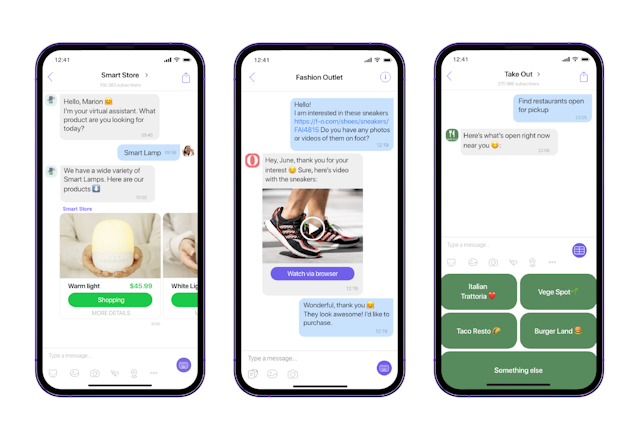As part of The Drum’s E-commerce Deep Dive, Cristina Constandache, chief revenue officer at Rakuten Viber, talks through the evolution of e-commerce, the rise of m-, s- and c-commerce, and the best ways to embrace online retail.
It’s no secret that technology and innovation tend to affect our daily lives, including how we do business. But retail and commerce are, arguably, among the most heavily impacted aspects of business life. The internet, the ebb and flow of consumer expectations, mobile-centric communications, and even high-tech developments such as artificial intelligence (AI) — all of these changes have impacted how we shop and how we sell.
We’ve seen a major growth in online shopping and the impact of online reviews on conversion. AI and natural language processing can now be used for all kinds of innovative solutions, from automatically “parsing” (breaking down and analyzing carefully) huge volumes of customer feedback — to using chatbots to offer recommendations to shoppers. CDPs (customer data platforms) have empowered businesses to use big data to literally study their customers, making it possible to personalize their outreach to enormous audiences.
CRMs and CDPs, for instance, have become so indispensable that today we almost take them for granted, but in reality they are a prime example of just how tremendous an impact innovation has already had. And it doesn’t end there: scientific progress grinds on, and with new technologies — new opportunities for businesses arise. In this article, let’s consider a few major developments in retail and how innovation is shaping the future of shopping.
Sell wherever and whenever your customers are ready to buy
The evolution of retail has made it more important than ever for companies to be where their customers are. Today, retail calls for a strong online presence, making use of multiple channels to reach the audience, and being available at all touchpoints of the customer journey.
As part of its evolution, e-commerce is now branching and diversifying too — meet conversational commerce, social commerce, and mobile commerce.
What is mobile commerce?
Mobile commerce, or m-commerce, is defined as “buying and selling services and goods via a mobile device (for example, a smartphone or a tablet).”
Consider two trends. Increasingly more consumers shop online; an increasingly larger proportion of what consumers do online is done via a mobile device. Result? M-commerce has been growing exponentially. For example, from 2020 to 2021, retail m-commerce sales grew by 15.2%; by 2025, they’re expected to constitute 44.2% of retail ecommerce sales in the US — or 10.2% of all retail sales.
The classic example of m-commerce is a customer purchases services or products via an app or a mobile website. But this isn’t the only way m-commerce can be used. For example, using messaging apps to facilitate commerce falls under this category and comes with a rich suite of features that make it easier to provide specific information to shoppers that can’t make up their minds, to highlight specific products, and to drive sales natively .
When using messengers for m-commerce, keep a few general recommendations in mind:
- Use the native messenger’s formatting and make your messages vibrant and easy to read.
- Focus on exclusive, personalized promotions and discounts rather than “spray-and-pray.”
- Include a call-to-action (CTA) in your promotional message — having a CTA button makes it easier to take an action.
- Use the same messaging app to provide customer support. You can answer customer questions in a live chat with your representative via business messages or use chatbots to respond 24/7. And for the customer, it minimizes the number of channels they have to use to be in touch with you.
- Use appealing images, messages with emoji, and vibrant videos showcasing your goods.
- When selling products that require delivery, use transactional messages to share tracking information and shipping updates.

M-commerce: examples from Viber for Business
What is conversational commerce?
Conversational commerce is a variety of e-commerce that facilitates commerce via natural conversations between brands and customers, letting clients place orders directly through chatbots, voice assistants, or live agent support. In other words, through a conversation that’s happening online.
The key advantage of c-commerce is that it allows businesses to offer a more personalized and seamless shopping experience. The customer can choose the color and size, ask questions on the spot, discuss the delivery, and pay for it — all within a single conversation. It’s convenient and hassle-free for customers, and it provides ample opportunities for interaction and conversion for the brand. The sales representative can highlight specific products based on the user story, give that personal touch that’s long remained the advantage of brick-and-mortar shops over online, and even talk a hesitant customer into going through with the purchase.
What can be used for conversational commerce? As opposed to social commerce, which uses specifically social networks in the context of online transactions, c-commerce can involve in-app conversational search, voice assistants, business messages that facilitate the shopping process in real time (for example via a messenger), and chatbots that answer questions and showcase product rosters 24/7. Messaging apps that have integrated payment capabilities, like Viber, can even allow users to shop without ever leaving the comforts of the app.
Aside from being the obvious convenience to users, two-way conversations between brands and clients make the shopping experience more interactive and personal, allowing businesses to build a stronger relationship with the audience, better connect with the customers, and, ultimately, drive sales.

Examples of c-commerce: chatbots and business messages via the Viber app
What’s next in store for retail?
If the pandemic taught us anything, it’s that detailed forecasts can be tricky. But a few key trends seem very likely to define the nearest future of retail.
1. The mobile-first world: mobile devices will likely continue their expansion into all facets of life
Consumers are increasingly using mobile devices to compare prices, research products, seek out deals, and, of course, shop. This trend is expected to intensify in the coming years.
2. The advent of superapps
Superapps provide multiple services, including payments, ordering transportation, food deliveries, messaging, and much more. Superapps are common in Asia, and now they’re starting to grow in popularity across the world as well. Superapps will continue to evolve and make use of innovative technologies, improving the range of features, tools, and integrations that enhance the shopping experience for customers.
3. Personalization
Brands can leverage data to personalize their customers’ experience. Behavioral and other data allows them to tailor offers, discounts, and promotions to each specific segment of the audience. Retailers are able to collect and analyze increasingly more customer information, so this trend can be expected to continue.
Takeaway
Thanks to the brisk pace of technological progress and innovation, the world of retail is evolving and shifting more rapidly than before. The lines between commerce and marketing are blurring, the audience becomes more engaged and connected, and companies are recognizing the advantages of a holistic, cross-discipline approach. By understanding the customers and their needs and leaning into the capabilities that innovation creates, brands can design a seamless, personalized, and omnichannel customer journey.
.